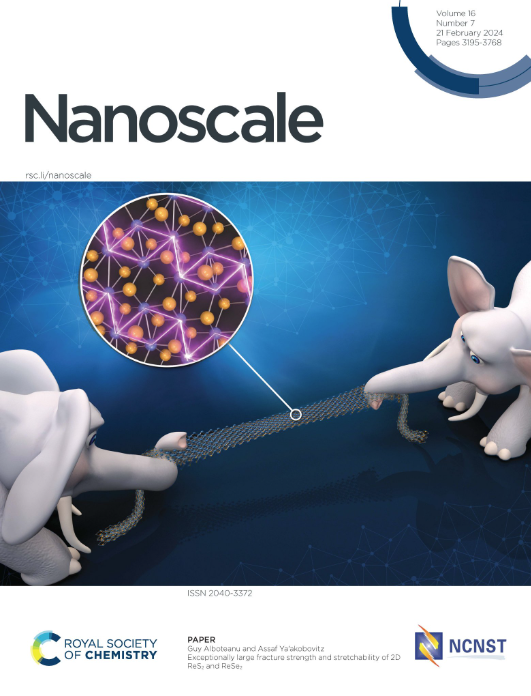Ultra-uniform high-quality plasmonic metasurfaces through electrostatic self-assembly of gold nanoparticles on chemically unmodified glass
IF 5.8
3区 材料科学
Q1 CHEMISTRY, MULTIDISCIPLINARY
引用次数: 0
Abstract
We present a novel method for the fabrication of ultra-uniform metasurfaces through the direct electrostatic self-assembly of positively charged gold nanoparticles (AuNPs) on chemically unmodified glass. The method was successfully applied to two types of ultra-uniform AuNPs like nanospheres and nanocubes differing in shape, size, and cationic surfactants ligands, proving the versatility of the proposed methods. Unlike previous studies, we found that the AuNPs clustering was due to an unproper drying of the metasurfaces after the deposition and not to instabilities of the colloids. Our fabrication methods resulted in metasurfaces of high densities and ultra-uniform arrangements with negligible clustering at both the microscale and macroscale, as confirmed by microscopic, spectroscopic, and nanophotonic analyses. Furthermore, thanks to far-field dipole couplings, the metasurfaces plasmon resonances resulted significantly narrower (and blueshifted) than the corresponding colloid. Combined to the ultra-uniformity feature, these plasmon phenomena increased the metasurfaces quality factors (Q) up to ∼15. Densities, uniformities, and Q-factors of our metasurfaces are among the highest reported until now for similar nanostructures realized through the electrostatic self-assembly technique. Our findings demonstrate new possibilities to achieve higher Q-factors through simple, scalable, and cost-effective electrostatic self-assembly processes, with practical implications in optical sensing and nanophotonics. Moreover, the ultra-uniformity achieved by our methods opens new opportunities to study the far-field dipole couplings in random arrays of anisotropic AuNPs.通过金纳米粒子在未经化学修饰的玻璃上静电自组装获得超均匀的高质量等离子体超表面
我们提出了一种通过在未经化学修饰的玻璃上直接静电自组装带正电的金纳米粒子(AuNPs)来制备超均匀超表面的新方法。该方法成功地应用于两种类型的超均匀aunp,如纳米球和纳米立方,其形状、大小和阳离子表面活性剂配体不同,证明了所提出方法的通用性。与以往的研究不同,我们发现AuNPs聚集是由于沉积后超表面的不适当干燥,而不是由于胶体的不稳定性。我们的制造方法导致高密度和超均匀排列的超表面,在微观和宏观尺度上都可以忽略聚类,正如显微镜,光谱和纳米光子分析所证实的那样。此外,由于远场偶极耦合,超表面等离子体共振比相应的胶体明显更窄(和蓝移)。结合超均匀性特征,这些等离子体现象将超表面质量因子(Q)提高到~ 15。我们的超表面密度、均匀性和q因子是迄今为止报道的通过静电自组装技术实现的类似纳米结构中最高的。我们的研究结果展示了通过简单、可扩展、经济高效的静电自组装工艺实现更高q因子的新可能性,在光学传感和纳米光子学方面具有实际意义。此外,我们的方法获得的超均匀性为研究各向异性aunp随机阵列中的远场偶极子耦合提供了新的机会。
本文章由计算机程序翻译,如有差异,请以英文原文为准。
求助全文
约1分钟内获得全文
求助全文
来源期刊

Nanoscale
CHEMISTRY, MULTIDISCIPLINARY-NANOSCIENCE & NANOTECHNOLOGY
CiteScore
12.10
自引率
3.00%
发文量
1628
审稿时长
1.6 months
期刊介绍:
Nanoscale is a high-impact international journal, publishing high-quality research across nanoscience and nanotechnology. Nanoscale publishes a full mix of research articles on experimental and theoretical work, including reviews, communications, and full papers.Highly interdisciplinary, this journal appeals to scientists, researchers and professionals interested in nanoscience and nanotechnology, quantum materials and quantum technology, including the areas of physics, chemistry, biology, medicine, materials, energy/environment, information technology, detection science, healthcare and drug discovery, and electronics.
 求助内容:
求助内容: 应助结果提醒方式:
应助结果提醒方式:


